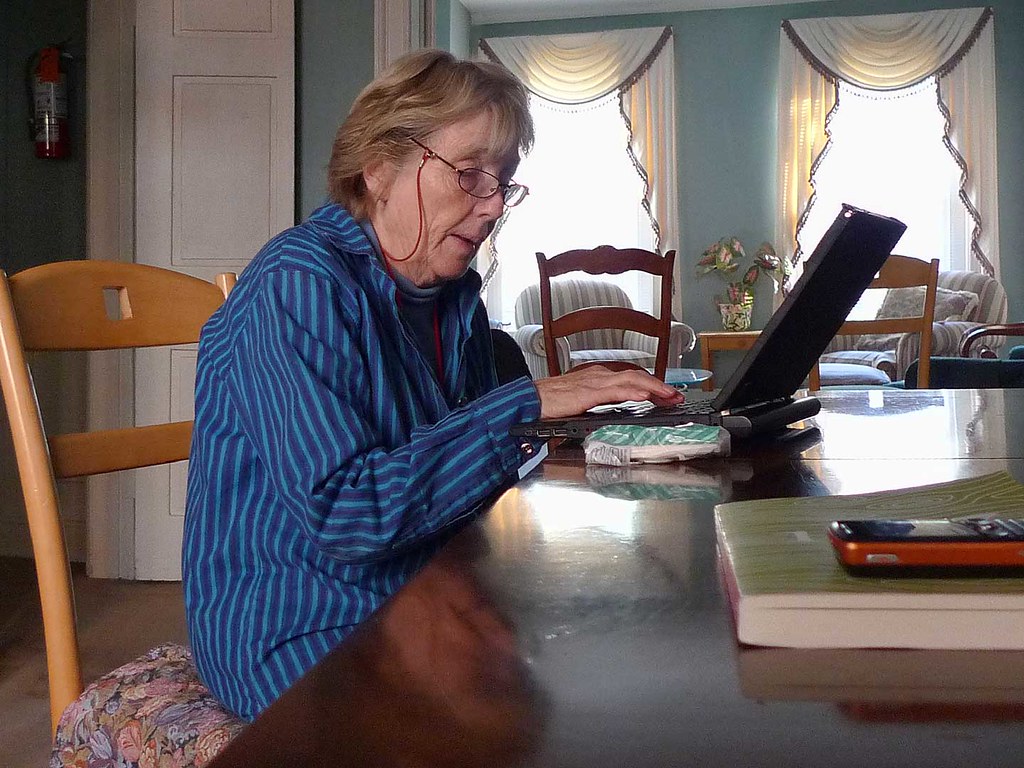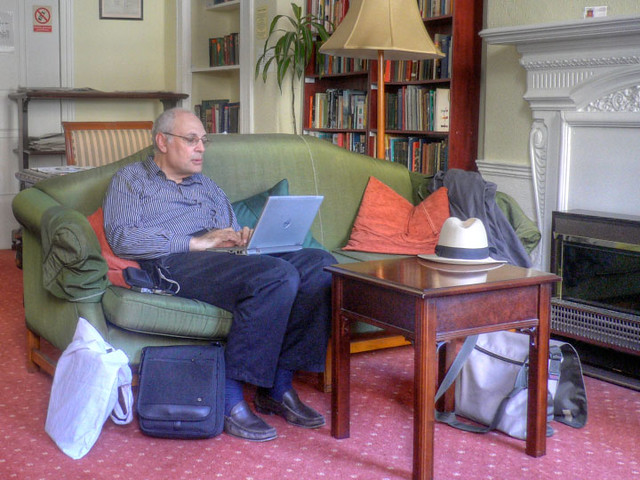.

Louis A. Caulfield, 37 Belfort Street, Dorchester. Delivering a heavy type-writer about a half a mile. Works for Model Typewriter Inspection Co. Says he is sixteen years old and gets $6 a week. Taken on Boston Common, Boston, Massachusetts: photo by Lewis Wickes Hine, January 1917 (National Child Labor Committee Collection, Library of Congress)

Wife of Pomp Hall, Negro tenant farmer, writing on typewriter. Through union activities the family has developed a desire for higher education. The typewriter is to them a symbol of that education and as such is the most prized family possession. Creek County, Oklahoma: photo by Russell Lee, February 1940 (Farm Security Administration/Office of War Information Collection, Library of Congress)

Chimpanzee seated at a typewriter: photo by New York Zoological Society, 19 May c. 1906 (Library of Congress)

Young woman with typewriter, FSA project, Pocatello, Banning County, Idaho: photo by Russell Lee, July 1941 or 1942 (Farm Security Administration/Office of War Information Collection, Library of Congress)

Woman at typewriter: photo by Howard Liberman, September 1942 (Farm Security Administration/Office of War Information Collection, Library of Congress)

A government secretary in the U.S. Office of Emergency Management, cleaning her typewriter: photo by Marjory Collins, February 1943 (Farm Security Administration/Office of War Information Collection, Library of Congress)

The Stenographer: photographer unknown, 5 March 1923 [?] (Library of Congress)

Typing address labels on a flat bed typewriter at the W. Atlee Burpee Company, seed dealers, Philadelphia, Pennsylvania: photo by Arthur S. Siegel, April 1943 (Farm Security Administration/Office of War Information Collection, Library of Congress)

Blind children from the Maryland School for the Deaf, Dumb and Blind coaching Senator Claude Pepper, of Florida, of Senate Committee, Washington, D.C., in the art of operating a braille typewriter (left to right: Frances Wright, 8 years old, reading a braille book; Andrew Birmingham, 10 years old; Dr. John W. Studebaker, U.S. Commissioner of Education; Senator Claude Pepper): photo by Harris & Ewing, 9 April 1937 (Library of Congress)

Robert Kit[...] at typewriter made by Joseph Alsop for Hartford Courant: photo by Harris & Ewing, 15 November 1937 (Library of Congress)

Typewriting department, National Cash Register, Dayton, Ohio: photo by William Henry Jackson, c. 1902 (Library of Congress)

Irene Cornyn at a typewriter, wearing a prosthesis on her arm, possibly using a modified typewriter: photo by Bain News Service, between 1910 and 1915 (George Grantham Bain Collection, Library of Congress)

Co-op enterprise office, Manzanar Relocation Center: photo by Anselm Adams, 1943 (Library of Congress)

Rose Fukuda and Roy Takeda, Manzanar Relocation Center: photo by Anselm Adams, 1943 (Library of Congress)

Indian stenographers: photo by Harris & Ewing, c. 1919 (Library of Congress)

Fanny Howe, Washington, D.C.: photo by Tom Raworth, 2010

Charles Bernstein, Bloomsbury, London: photo by Tom Raworth, 15 May 2008
[W]ord processor ideology reinforces the idealization of "clean copy" -- a defleshed, bureaucratic and interchangeable writing.
____
To understand the work of Charles Bernstein, one needs to think hard about fashion, in clothing and in print(s). For Bernstein, unlike his self-proclaimed precursor, Laura (Riding) Jackson, even nakedness is disguise, and power is at once naked and hidden by the audience’s desire, if not under actual or metaphorical cloth. The poet, quite simply and comically, can never take off his clothes:
Should I choose to take my tie off, the one with the embossed seals that is so carefully knotted over my Adam’s apple, I do not fall into a state of undress. I remain clothed, in some fashion or other, until I am without clothes and indeed then my skin still encloses me, until I disappear. (The real moral of "The Emperor’s New Clothes" is that power is always naked and by force of that concealed by the modesty of a people who cannot bear to look at the spectacle without mediation: the Emperor is clothed, that is, by the self-protective squeamishness of the collective subconscious. (Content’s Dream: Essays 1975-1984)
Unlike Riding, however, and more like Gertrude Stein, from whom he takes more than from any other writer, Bernstein relishes his position and destabilizes it at every turn. Like Stein, he uses his criticism (much more standard than hers) to advertise his poetry. It remains to be seen, however, to what extent Bernstein is able to maintain his anti-fashionable status at the moment when fashion is catching up with him, or if his strategy of disavowing fashion by indulging in it succeeds in dismantling other, more ready-made styles. I will end this essay with a final paradox: Bernstein does not so much disavow authority in his work as reconceptualize it. Given a climate in which authority is a suspect term, Bernstein realizes that the only way to have it may be to disavow it.
from Susan M. Schultz: Of Time and Charles Bernstein's Lines: A Poetics of Fashion Statement, in Jacket #14, July 2001

# 657 (Brighton): photo by Tom Raworth, 2 August 2011



9 comments:
And see also: more unfashionableness.
At first glance, I was tempted to stay with the chimp and write you something about that. But you've made an unexpected poem of these materials, which is really saying something for a website where you expect to find poetry. The only thing I can find words for now are the remarkable range of very moving typewriter photos. I would never have thought about examining the world in this way through this lens. Curtis
Thanks, Curtis. Yes, for me too, this was a learning experience.
A classic: Charles Bernstein sells fashionable poetry with or without its usual accoutrements whereas Tom Clark makes poetry using only a lens focused on a typewriter.
Yes, I agree. And it makes me think of what they were all writing . . . I love old books, phrases . . .
just a dated word or two makes me happy.
I have these old books I like to open just to read a section, just because . . .
like right now, I will open this Wonder World book from 1914 that has excerpts from literature.
Okay - -
A tiny excerpt . .
"They had plenty of meat for their breakfast, though--such as it was--and came nigh paying dearly enough for it . . . "
That's from The Boy Hunters of Mississippi by Captain Mayne Reid.
I'm doing justice to your post, which is, as always impossible to do justice to . . .
I tend towards a posturing that is
within & without
de:void
of any (what does CB do?) 'conceptualizing'
more-so of need is to re-contextualize/re:assemble
out of that vast storehouse of
"stuff" that is The Mind.
not to 'kick a dead horse'
but
one runs the risk of becoming what they pretend to be
rather than just being the medium through which
a piece of art or a poem
does what it does in it s OWN context..
I just don't "get 'it'". what are these guys and gals are doing-teaching ?
1943 ! my mother was typing in an office The War Department here in D.C.
stuff similar to those pictures in ...
long about 1956 or so after I took a junior high school typing class she bought me a used typewriter just like the one that she had used.. an Underwood 5
hang in,
as
I am on my way to Value Village to get me some used baggy clothes so's I look just like a Right Now Cool Professor !
I love vazambam's description. I remember an earlier meditation on typing and typewriters here centered on an Aram Saroyan poem. My relationship with my various word keyboards is certainly a central part of my life and I know it’s true that I was affected as much by my experience in typing (and driver’s ed.) as by any other part of my education. Years ago, the person who was working as my assistant at the time at CBS/FOX marveled about the fact that I was as good a typist as she. Everything about office procedure changed then for the typewriter-capable and I no longer utilized my assistants’ services for preparing contracts, memos and letters. Their mediation just slowed me down, so instead I typed away and they surfed the web and planned their weddings. At least they invited me to them and we all remain good friends. Now, none of them are typing at all any more and I’m typing more than ever. I enjoy it. Somehow, it’s how I think and the only manual task (except for cooking, I suppose) where I’ve shown the least amount of skill.
Thank you, lovely unfashionable people.
After destroying a shoulder in a bike crash in the Santa Ynez Mountains I did not type for twenty-some years.
(Autobiographical revelations are tiresome, but the presence of an ardent cyclist among us, first initial V, perhaps provides a shred of relevance, here -- ?)
Strictly handwriting, it was, then. That was pleasant, one could do it outdoors, one even knew where the outdoors was.
When eventually I stutteringly approached the keys again, they had changed but I had not. It was back to the old two-finger hunt-and-peck, only slower. More... uh... meditative.
Women have always been better typists than men. The historical photo evidence bears this out. I suppose the men made them do it, to start with.
The business men.
In another passage cited in the long article briefly quoted here, the fashionable traveler proposes that he is a businessman of poetry. Nowadays I believe businessmen travel with their laptops and are never far from a keyboard. Though it must be admitted all I know about this is what I see in photographs. Though I do know what a lap is.
And speaking of tops... yes, Nin, almost any scrap of text picked up by chance (or serendipity?) from the top of the pre-world heap retains a curious happymaking potential.
"They had plenty of meat for their breakfast, though--such as it was--and came nigh paying dearly enough for it . . . "
Now that is the sort of story that awakens the imagination.
Tom,
How wonderful to find TR's photo of Fanny Howe here (after all that black and white) -- and all else, as always. . . .
9.30
light coming into fog against invisible
top of ridge, black of leaves of branch
in foreground, wave sounding in channel
tonal variation, repetition
after something after
thinking only, fragments of
meaning, left of work
grey white of fog reflected in channel,
whiteness of gull gliding toward point
Post a Comment